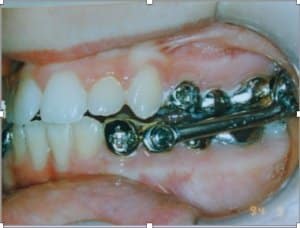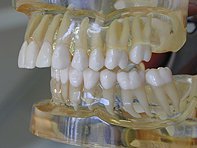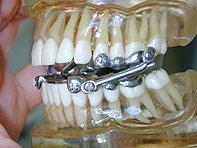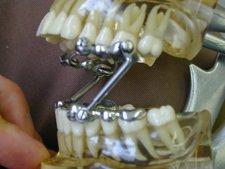The Herbst-Appliance is a fixed brace used for the treatment of the retruded lower jaw (Angle Class II). A typical Herbst-Appliance consists of two metal rails that are cemented to the upper and lower posterior teeth and two telescopic attachments that, once inserted, immediately bring the lower jaw forwards. The Herbst-Appliance allows both forward and sideward movement of the jaw and also allows the mouth to open fully, but it prevents the lower jaw from moving backwards.
History
The Herbst-Appliance was first introduced by Emil Herbst in 1931, but was initially ignored and was neglected for decades. One of the reasons for this was the high need of repair regarding the old models which is not a problem with the innovative Herbst-Scharniere nowadays. It was re-discovered in 1979 by Hans Pancherz. Since then, Pancherz and many other writers have all published studies about the Herbst-Scharnier so that it has become the best-researched brace ever.

Effect
The Herbst-Appliance works just like an Activator that is worn for 24 hours a day. Actually the Herbst is more efficient than an Activator which only works when the mouth is closed, whereas the Herbst-Appliance works all the time. For this reason, most adolescent lower-jaw overbite problems can be corrected within 9 months. So the Herbst-Appliance outperforms the slow and often deficient Activator in a fraction of time. This is why it is such an effective appliance. As is the case with the ‘functional orthopedic’ double plates, the effect produced by the Herbst comes mainly from tooth movement rather than being a result of skeletal effects. And the small skeletal changes largely disappear during the years following treatment, so that in the long term, not even the Herbst can bring about any noticeable lengthening of the lower jaw. Traditionally, the Herbst-Appliance has just been used for adolescents but it is now also used for adults who are in their forties and it can even be an alternative to dysgnathic surgery.
Advantages
It’s an extremely effective dental appliance that doesn’t require the patients’ cooperation.
Disadvantages
Expensive, often needs repair, requires a lot of medical time; is uncomfortable for many patients and a second course of treatment with brackets is almost imperative.
Herbst clones
The therapeutic principle of the Herbst-Appliance has been replicated by dozens of forward-acting mechanisms over the years. Some are almost identical to the Herbst-Appliance, e.g. the Eureka Spring, the MALU brace, the SUS Spring or the Bio-Bite-Corrector, whereas others are more elastic but are mechanically the same. These include the Jasper Jumper, the Forsus Spring and the Bite Fixer (the list could be extended endlessly). The advantage of many Herbst clones is that they can be connected to the fixed appliance and the treatment procedures can be carried out within a single phase, whilst the Herbst-Appliance requires two treatment phases. Skillful use of Herbst clones can significantly shorten the treatment duration while increasing its effectiveness.



